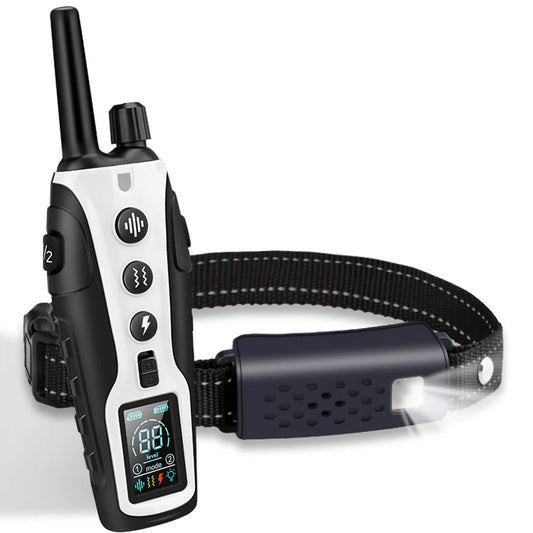How To Stop Dog Barking: Understanding why dogs bark: Before trying to stop your dog from barking, it's important to understand why they bark. Barking is a form of communication, and dogs bark for different reasons, such as fear, excitement, boredom, or as a warning. Understanding the reason behind the barking can help you address the behavior more effectively.
Dogs are one of the most popular and beloved pets in the world. However, they can be quite vocal, and barking is a common behavior that many dog owners struggle with. While excessive barking can be frustrating for owners, it's important to understand that barking is a natural behavior for dogs, and it's often their way of communicating with their environment.
One reason why dogs bark is out of fear. If a dog feels threatened or in danger, they may bark as a way of warning their owners or other animals. This type of barking is usually loud and sharp, and it's often accompanied by other signs of anxiety, such as a raised hackles or a crouched posture.
Dogs may also bark out of excitement or anticipation. For example, a dog may bark when they see their owner approaching, or when they're playing with their favorite toy. This type of barking is usually high-pitched and repetitive, and it can be quite challenging for owners to control.
Boredom is another common reason why dogs bark. If a dog doesn't have enough mental or physical stimulation, they may resort to barking as a way of releasing their pent-up energy. This type of barking can be persistent and continuous, and it can be difficult to stop without addressing the underlying cause.
Lastly, dogs may bark as a way of warning their owners or other animals. For example, a dog may bark when they sense an intruder or a stranger approaching. This type of barking is usually deep and low-pitched, and it's often accompanied by other signs of aggression, such as a raised tail or a stiff posture.
Understanding why your dog is barking is the first step in addressing the behavior. Once you identify the reason behind the barking, you can take steps to address the underlying cause, such as providing more exercise and mental stimulation, or working with a professional trainer to address fear or aggression issues. With patience and consistency, you can help your dog develop better communication skills and reduce their excessive barking.
How to get a dog to stop barking
Positive reinforcement training: One effective way to stop your dog from barking is through positive reinforcement training. This involves rewarding your dog for good behavior, such as being quiet or obeying a command, and ignoring or redirecting unwanted behavior. Consistency and patience are key when using this approach.
Positive reinforcement training is a highly effective method for addressing unwanted barking in dogs. This approach involves rewarding your dog for exhibiting desirable behaviors, such as being quiet or obeying a command, and ignoring or redirecting unwanted behaviors, such as excessive barking.
The goal of positive reinforcement training is to teach your dog that good behavior is rewarded, while undesirable behavior is ignored or redirected. Rewards can take the form of treats, praise, or playtime, and they should be given immediately after the desired behavior is exhibited. This helps to reinforce the connection between the behavior and the reward, making it more likely that your dog will repeat the behavior in the future.
In the case of excessive barking, positive reinforcement training can involve rewarding your dog for being quiet. This can be done by giving your dog a treat or praise when they stop barking, or by redirecting their attention to a toy or activity that they enjoy. Over time, your dog will learn that being quiet is a desirable behavior, and they will be more likely to exhibit this behavior in the future.
Consistency and patience are key when using positive reinforcement training. It's important to reward your dog consistently for good behavior, and to ignore or redirect unwanted behavior every time it occurs. This helps to reinforce the desired behavior and discourage unwanted behavior.
Positive reinforcement training can be a highly effective way to address unwanted barking in dogs. It's a humane and gentle approach that can help to strengthen the bond between you and your dog, while also teaching them important communication skills. With consistency and patience, you can help your dog learn to control their barking and become a well-behaved and happy member of your family.
Providing your dog with adequate exercise and mental stimulation is an important aspect of managing unwanted barking behavior. Dogs that are bored or have pent-up energy are more likely to bark excessively, so it's essential to provide them with opportunities to release their energy in a positive way.
One way to provide your dog with exercise is to take them for daily walks. Regular walks help to burn off excess energy and provide your dog with mental stimulation as they explore their environment. It's important to make sure that your dog is getting enough exercise for their breed and age, as some dogs require more exercise than others.
Mental stimulation is also important for reducing barking behavior. Puzzle toys, such as treat-dispensing balls or interactive games, can help keep your dog's mind active and engaged. Training sessions, such as obedience or agility training, can also provide mental stimulation while helping to reinforce good behavior.
When providing exercise and mental stimulation, it's important to remember that consistency is key. Aim to provide your dog with regular opportunities for exercise and mental stimulation, and make sure that you're using activities that your dog enjoys. This will help to keep your dog motivated and engaged, and will help to reduce their desire to bark excessively.
Stop dog barking Using deterrents
There are various deterrents you can use to stop your dog from barking, such as noise-emitting devices, sprays, and citronella collars. These methods can be effective in certain situations, but it's important to use them appropriately and with caution.
Deterrents can be a useful tool in managing excessive barking behavior in dogs. There are several different types of deterrents available, including noise-emitting devices, sprays, and citronella collars.
Noise-emitting devices, such as ultrasonic bark control devices, emit a high-pitched sound when your dog barks. The sound is designed to be unpleasant to dogs, and can help to discourage excessive barking behavior. Sprays, such as bitter apple spray or water sprays, can also be used to deter barking by providing an unpleasant sensation when your dog barks.
Citronella collars are another type of deterrent that can be effective in reducing barking behavior. These collars release a spray of citronella when your dog barks, which can be unpleasant and distracting for your dog. While citronella collars can be effective in some cases, it's important to use them appropriately and with caution, as they can be uncomfortable or stressful for some dogs.
It's important to note that while deterrents can be effective in managing excessive barking behavior, they should be used in conjunction with other behavior modification techniques, such as positive reinforcement training and providing adequate exercise and mental stimulation. It's also important to use deterrents in a humane and responsible way, and to avoid using them as a substitute for proper training and care.
In summary, deterrents can be a useful tool in managing excessive barking behavior in dogs, but they should be used appropriately and with caution. Noise-emitting devices, sprays, and citronella collars can all be effective in certain situations, but should be used in conjunction with other behavior modification techniques. With proper training and care, you can help your dog learn to control their barking and become a well-behaved and happy member of your family.
Seeking professional help: If your dog's barking is excessive or persists despite your efforts, it may be helpful to seek the advice of a professional dog trainer or behaviorist. They can assess your dog's behavior and provide tailored recommendations to address the barking.
If you've tried various methods to stop your dog from barking and the behavior persists or becomes excessive, it may be time to seek the help of a professional dog trainer or behaviorist. These experts can assess your dog's behavior and provide tailored recommendations to address the underlying causes of the barking.
Professional trainers and behaviorists are experienced in working with dogs of all breeds and temperaments, and they can provide personalized training plans to help your dog overcome their barking behavior. They can also help you identify any underlying health issues or environmental factors that may be contributing to the barking.
Working with a professional can also help you to ensure that you're using the most effective techniques for your dog's specific needs. They can help you to refine your training methods and provide ongoing support to help you and your dog achieve your training goals.
When seeking professional help, it's important to choose a reputable and qualified trainer or behaviorist. Look for someone with experience working with dogs of your dog's breed and age, and check their credentials and references before making a commitment.
In summary, seeking professional help is a valuable option for addressing excessive or persistent barking behavior in your dog. A qualified trainer or behaviorist can assess your dog's behavior and provide tailored recommendations to help you and your dog achieve your training goals. With their expertise and support, you can help your dog overcome their barking behavior and become a well-behaved and happy member of your family.
Real-life success stories of using anti-barking devices on neighbor's dogs
Dog barking can be a major annoyance, especially if it's not your own dog. When a neighbor's dog constantly barks, it can disrupt your peace and quiet and make it difficult to relax or concentrate. In such cases, using an anti-barking device can be a useful tool to control the barking behavior. Here are some real-life success stories of using anti-barking devices on neighbor's dogs:
- Sarah's Story Sarah had a neighbor who had a dog that would bark constantly, even in the middle of the night. She tried talking to her neighbor, but nothing worked. She decided to purchase an ultrasonic anti-barking device and placed it on her fence facing her neighbor's yard. Within a few days, the barking reduced significantly, and eventually, the dog stopped barking altogether. Sarah was able to enjoy her peaceful evenings and get a good night's sleep.
- John's Story John's neighbor had two dogs that would bark all day long while he was trying to work from home. He tried talking to his neighbor, but the dogs continued to bark. He decided to try a spray bark collar, which emits a burst of citronella spray when the dog barks. After a few days of use, the dogs stopped barking excessively, and John was able to work in peace.
- Lisa's Story Lisa lived in an apartment complex where her neighbor's dog would bark constantly, even when the owner was at home. She tried talking to her neighbor, but the barking continued. She decided to try a vibration anti-barking device, which emits a vibration when the dog barks. Within a few days, the barking reduced significantly, and eventually, the dog stopped barking altogether. Lisa was able to enjoy her quiet apartment without the constant disturbance.
In conclusion, anti-barking devices can be effective in controlling a neighbor's dog's barking behavior. However, it's essential to use them in a humane and responsible way. It's also important to remember that anti-barking devices are not a substitute for proper training and exercise for the dog. If the barking behavior persists, it may be necessary to seek professional help from a dog trainer or behaviorist.
Also, you can see our social media:




